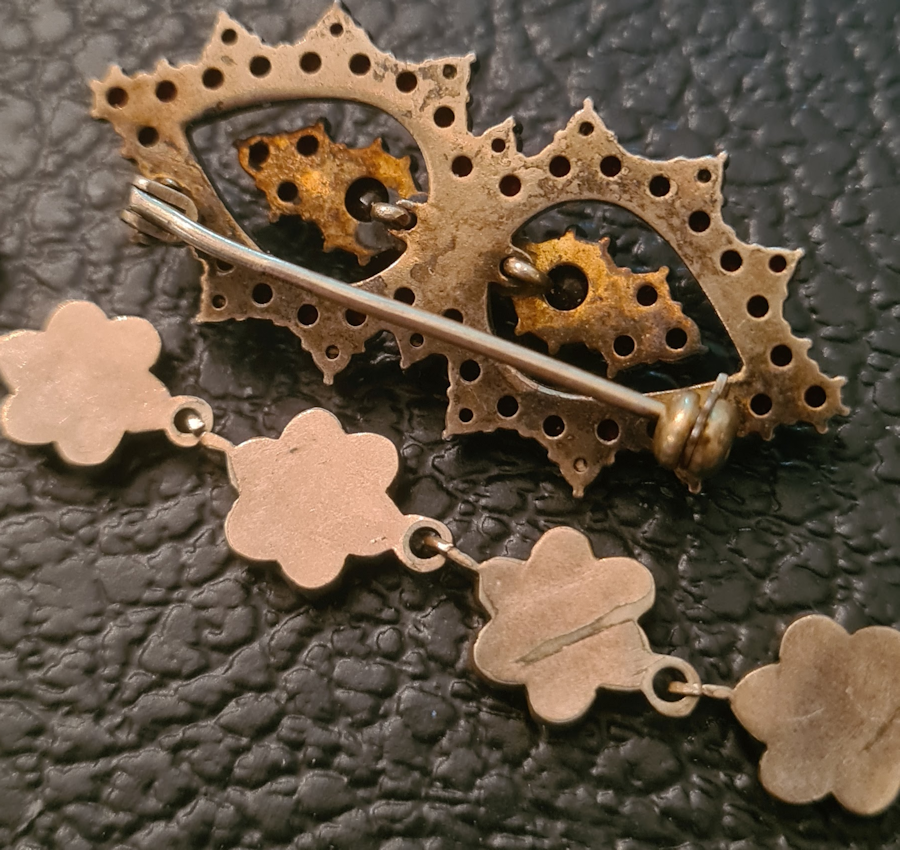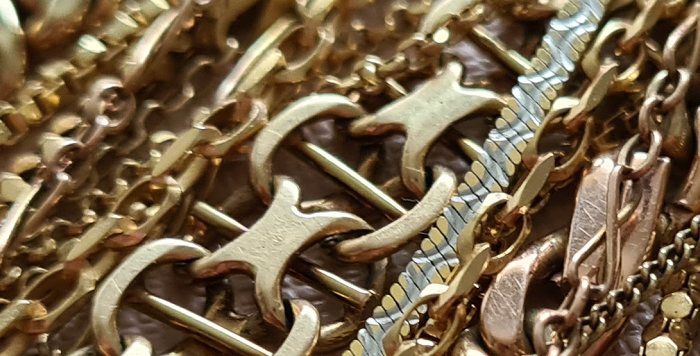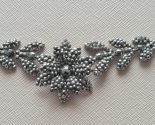
Deciding what to collect
When does your jewellery box turn into a collection? In my mind at least, it happens when you actively search out something in particular, rather than just buying something because it looks nice. Consider the made-up jewellery box of the just as made-up Georgina. It’s just her jewellery. She didn’t collect it, she just bought (or was gifted) pieces of jewellery throughout her life. Still, you can treat your limited collection of antique jewellery just as a serious collector would and benefit from wise purchases and items that go well together and fit your needs.
Collecting antique jewellery
So, in order to be a collector of antique jewellery, you need some sort of intent. You are trying to find something in particular, something that meets certain requirements. Now, I’m not saying that we all need to be collectors. I’d say most lovers of antique jewellery just like nice jewellery and have a preference, for some reason or another, for the good old stuff. But even then, it makes sense to have the perspective of an actual collector, find out what you like, what you value, what you “need”, and why.
A collection can be so many different things. Maybe you’re collecting cameos. Maybe hair jewellery in all shapes and sizes is your thing. Maybe you have a favourite London goldsmith and only collect items made by him and his team. You could love moon stones or the garland style. And even if you’re not really a collector, knowing the must haves, wants, wishes and deal breakers that apply to YOU will help you figure out what you want (what you really, really want).
We’ll start off with the negatives because, let’s face it, it is often easier to tell exactly what we don’t want than what we do want.
Deal breakers
Find your deal breakers. These are the things that turn that lovely piece into something you really shouldn’t buy. There aren’t any objective rules here, so you have to make your own. Some examples you may want to consider are:
- Low-grade gold or plate
- Visible repairs
- Alterations
- Missing pieces
- Wear and tear
- Missing hallmarks
- Synthetic stones/paste

Keep in mind that a deal breaker is absolute – these aren’t just the things outside of your wish list, these are the things that you expressively do not want. See, in the heat of the moment, you may want to forget all about the deal breakers because you’re looking at the most stunning piece of jewellery you have ever laid your eyes on, and unless you want to regret your choices when those rose-tinted glasses come off, you should always remember your deal breakers.
To some, deal breakers may be strictly connected to the material value of the piece (more about the value of antique jewellery here), while to others, wearability is and should be crucial. Let’s say you’re collecting Georgian rings. Let’s say you already have 20 rings and find one that is absolutely perfect, save for the band being so worn it cannot be safely used on a daily basis. To you, that may not be an issue at all, as you’re most likely to just keep it in a box and look at it every now and then, and maybe resell it in 5 years. If you buy to wear, however, this ring would be useless, and a lack of wearability should very much be on your deal breaker list.
Wearability is about more than the item being able to withstand being worn, though, it’s also about fitting you and fitting into your lifestyle. I would very much love to get my hands on a tiara that can be turned into a necklace, but I have absolutely no use for a tiara or an extremely opulent necklace, so even if I stumbled upon a huge fortune, it would make no sense for me to get something I’d never wear. Similarly, you will have little use for earrings if you don’t have pierced ears, and if all your clothes are pink, a pendant with citrines may not be a good investment.
Must haves
Must haves are obviously the opposite of deal breakers, and these too are completely up to you. Some examples (in addition to the opposites of the deal breaker examples) may be:
- Age
- Style
- Theme
- Type of item
- Country of origin
Must haves are what your collection is about, and you can have just one or a lot of them. Maybe you collect any and all kinds of jet jewellery. Maybe you collect 15 ct gold lockets from the late Victorian period. Regardless, these are the framework of your collection.

Wants and wishes
These may on first glance appear to be two sides of the same coin, but while related, they are not the same. Your wants are a subset of your must haves; they aren’t absolutes, but they are pretty important to you, and will help you choose between two potential investments. Let’s say at least 15 ct gold is a must have, but 18 ct is a want. When trying to choose between two pieces that are otherwise equally good investments to you, that will help you pick the right one. A want may be price related too – maybe you want to keep the price below £500, while £700 and above is a deal breaker.
Wishes are more flexible and may change all the time. They are usually linked to your must haves and wants, but they can be very specific. Let’s say you collect antique gold necklaces – those are your must haves, you want 18 ct gold and genuine gemstones, but you’ve been watching “Bridgerton” lately, so you’re looking for a Georgian necklace and you’re willing to accept paste instead of the real deal. A wish cannot collide with your must haves – if that happens, you’ll have to reevaluate your must haves.
Some final advice for collecting antique jewellery
My advice is to make an actual list for yourself with all of these points. Not only will they help you avoid unwise purchases, they will help you pinpoint what’s important to you, what to search for if you’re shopping online, and truly figure out what your collection of antique jewellery is all about, if that’s still a bit unclear to you.
All jewellery that’s not modern costume jewellery is an investment, and knowing what you actually want will help you spending your money more wisely. The size of your jewellery collection matters not, what matters is that it brings you joy!






-
-
3 years
Tagged gold